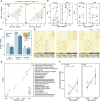Adaptation to Nighttime Light via Gene Expression Regulation in Drosophila suzukii
- PMID: 40800166
- PMCID: PMC12339407
- DOI: 10.1002/ece3.71971
Adaptation to Nighttime Light via Gene Expression Regulation in Drosophila suzukii
Abstract
Urbanization causes environmental changes like habitat loss, fragmentation, and pollution, which reduce biodiversity. Urban organisms face stressors, such as heat islands, air and water pollution, and anthropogenic noise, all of which can disrupt their development, behavior, and physiology. While some species adapt to urban environments, their responses and the role of evolution in urbanization are limited, as most studies focus on phenotypic traits. Artificial light at night (ALAN), a common urban stressor, disrupts behaviors and physiological processes, including circadian rhythms, sleep, and reproduction. The present study examined the effect of ALAN on body size, survival, activity rhythms, and gene expression in urban and rural strains of Drosophila suzukii in common garden experiments. ALAN reduced wing and thorax sizes regardless of sex and origin, decreased survival in rural populations, and increased it in urban populations. ALAN elevated overall activity, especially in the early night, while urban females displayed reduced sensitivity regarding activity and sleep. The circadian rhythm length was disrupted in rural populations but not in urban populations. Transcriptomic analysis revealed ALAN-induced gene expression changes, particularly in urban females, with photoreceptor- and circadian rhythm-related genes responding differently between urban and rural populations. These results indicate that urban populations have evolved adaptive mechanisms to counter ALAN's effects, likely mediated through gene regulation. This study highlights ALAN's impact on diverse traits and its potential for adaptive evolution in urban environments. Evolutionary adaptations in traits related to urban stress responses may enhance the ecological success of D. suzukii in urban habitats.
Keywords: circadian rhythm; gene regulation; light pollution; plasticity; transcriptomics; urban adaptation.
© 2025 The Author(s). Ecology and Evolution published by British Ecological Society and John Wiley & Sons Ltd.
Conflict of interest statement
The authors declare no conflicts of interest.
Figures





Similar articles
-
Transcriptome-wide deregulation of gene expression in zebrafish exposed to artificial light at night.Environ Pollut. 2025 Oct 1;382:126683. doi: 10.1016/j.envpol.2025.126683. Epub 2025 Jun 16. Environ Pollut. 2025. PMID: 40532811
-
Behavioural rhythms of two amphipod species Marinogammarus marinus and Gammarus pulex under increasing levels of light at night.PLoS One. 2025 Aug 7;20(8):e0329449. doi: 10.1371/journal.pone.0329449. eCollection 2025. PLoS One. 2025. PMID: 40773521 Free PMC article.
-
The Black Book of Psychotropic Dosing and Monitoring.Psychopharmacol Bull. 2024 Jul 8;54(3):8-59. Psychopharmacol Bull. 2024. PMID: 38993656 Free PMC article. Review.
-
Sexual Harassment and Prevention Training.2024 Mar 29. In: StatPearls [Internet]. Treasure Island (FL): StatPearls Publishing; 2025 Jan–. 2024 Mar 29. In: StatPearls [Internet]. Treasure Island (FL): StatPearls Publishing; 2025 Jan–. PMID: 36508513 Free Books & Documents.
-
Management of urinary stones by experts in stone disease (ESD 2025).Arch Ital Urol Androl. 2025 Jun 30;97(2):14085. doi: 10.4081/aiua.2025.14085. Epub 2025 Jun 30. Arch Ital Urol Androl. 2025. PMID: 40583613 Review.
References
-
- Bennie, J. , Davies T. W., Cruse D., Inger R., and Gaston K. J.. 2018. “Artificial Light at Night Causes Top‐Down and Bottom‐Up Trophic Effects on Invertebrate Populations.” Journal of Applied Ecology 55: 2698–2706.
-
- Chen, Y.‐R. , Wei W.‐L., Tzeng D. T. W., et al. 2021. “Effects of Artificial Light at Night (ALAN) on Gene Expression of <styled-content style="fixed-case"> Aquatica ficta </styled-content> Firefly Larvae.” Environmental Pollution 281: 116944. - PubMed
Associated data
LinkOut - more resources
Full Text Sources

